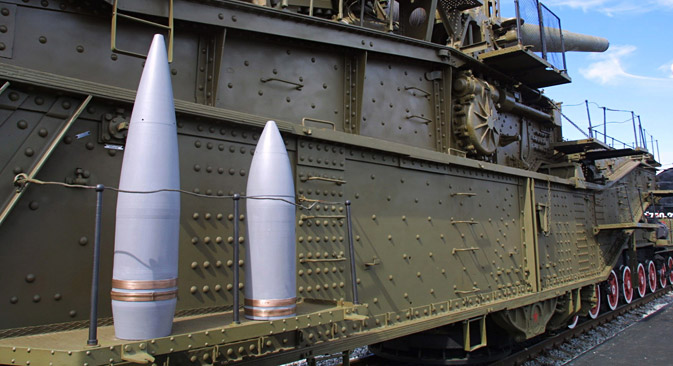Russia may resume production of nuclear missile trains

Soviet-Russian nuclear trains are quite expensive and rather hard to operate, but their main advantages – stealth and surprise – are worth the trouble. Source: PhotoXPress
Russia is planning to resume the production of rail-mobile ballistic missile systems, an unnamed senior official at the Russian military-industrial complex told RIA Novosti.
One would be forgiven for being sceptical about the project if it were not for three compelling factors. The first is the repeated statements by Russian military officials, including Deputy Commander of the Strategic Missile Forces Lieutenant General Vladimir Gagarin (autumn 2009), about the need to revive the production of missile trains. In December 2012, Commander of the Strategic Rocket Forces Lieutenant General Sergei Karakaev told reporters that the work to create rail-mobile ballistic missile systems was already underway.
The second reason is that Russia now in a position, both politically and financially, to restore the “vengeance weapon” that it destroyed hastily in the mid-2000s in order to meet its commitments under the START II Treaty, despite the fact that it was never even ratified (although experts argue that not all of the Russian nuclear missile trains were in fact destroyed). From a political point of view (read: political will), this means using rail-mobile ballistic missile systems as an appropriate response to the lack of guarantees from America and Europe that the European missile defence system will not be used against Russia. “By 2020, the European missile defence system plans to adopt new modifications to the SM-3 missile, capable of intercepting Russian ICBMs. In light of this fact, Moscow will have to take appropriate counter measures,” says Igor Korotchenko, director of the Centre for Analysis of World Arms Trade. “The high hopes that we had placed on the development of Russian-American relations after the START III Treaty was signed were never fulfilled. The strategic partnership announced by the American administration proved to be a mere declaration. A new treaty to further limit strategic offensive arms is unlikely. This is why the restoration of missile trains is very important: along with the heavy liquid-fuelled missile, they will become an effective deterrent to the United States’ nuclear ambitions and its aggressive military plans,” says Strategic Rocket Forces veteran Yuri Zaitsev, Academic Advisor at the Russian Academy of Engineering Sciences.
Related:
Russia to roll out new hypersonic missiles
Russian-Chinese military and technical cooperation takes off anew
Soviet-Russian nuclear trains are quite expensive and rather hard to operate, but their main advantages – stealth and surprise – are worth the trouble. They are neither silos, where a missile can be intercepted when it leaves the launcher, nor automobile launch systems, which have a limited range of 300–400 kilometres and are easy to see from space, given contemporary surveillance technologies. A missile train is a standard train that comprises a few refrigerator, mail and passenger cars that is capable of travelling 1,000 kilometres in 24 hours along regular rails and launching the first missile with a range of 10,000 kilometres and 10 warheads within three minutes of command (the Strategic Rocket Forces operated 12 trains of this kind armed with 36 missiles). Financially, Russia is capable of resuming missile train production. Deputy Prime Minister Dmitry Rogozin said today that the number of state defence contracts would double to more than 2 trillion roubles in 2014 compared to 2012.
The third reason for Russia to revive its nuclear missile trains is the technical capability of the country to build such trains. Designers will now have to adapt the old rail-mobile ballistic missile system project to the new missile, either the Bulava or Yars (the production of the special rail-based missile RT-23 UTTKh Molodets remained in Ukraine and was demolished); military railmen will need to restore the surface infrastructure at home stations, near Kostroma, Perm and in Krasnoyarsk Region (eyewitnesses claim that the one in the vicinity of Kostroma is in a state of ruin). However, judging by indirect information, the Russian defence complex has even more ambitious plans for missile trains. One of the main challenges for the rail-mobile ballistic missile system is its limited endurance and the need for refuelling (if driven by a diesel locomotive), as well as the low capacity of its power unit. Three locomotives were required to pull a Soviet nuclear train, which naturally unmasked the train. Back in the early 1980s, an alternative was designed for the nuclear train project – a locomotive powered by the BOR-60 fast fission reactor (with a heat power of 60MW and electrical power of 10 MW). However, the locomotive was never built. In February 2011, Russian Railways Vice President Valentin Gapanovich told reporters that the railway operator and the state corporation Rosatom would present the design of a new nuclear-powered train to the public by the end of 2011. There have been no reports about the project since then, which suggests that the locomotive is being developed by defence agencies.
However, there was enough time for military railway specialists to test the gas turbine locomotive working on liquefied natural gas, created back in 2006 on the basis of one of Nikolai Kuznetsov’s gas-turbine engines. In 2009, the engineering prototype of the locomotive was entered into the Guinness Book of World Records, pulling 159 carriages weighing 15,000 tonnes on a test track. The machine has a fuel capacity of almost 1,000 kilometres. It is an almost perfect locomotive to move the nuclear missile train (the perfect one being the nuclear-powered machine). But there have thus far only been reports about the civil use of the gas turbine locomotive – the Sinara group plans to build 40 locomotives of this kind for Russian Railways, which will operate them in the Far North and the Far East.
First published in Russian in the Expert magazine.
All rights reserved by Rossiyskaya Gazeta.
Subscribe
to our newsletter!
Get the week's best stories straight to your inbox